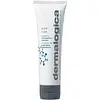What's inside
What's inside
 Key Ingredients
Key Ingredients

No key ingredients
 Benefits
Benefits

 Concerns
Concerns

 Ingredients Side-by-side
Ingredients Side-by-side

Water
Skin ConditioningPropylene Glycol
HumectantCaprylic/Capric Triglyceride
MaskingGlycerin
HumectantCetyl Alcohol
EmollientSucrose Polystearate
EmollientJojoba Esters
EmollientNiacinamide
SmoothingHippophae Rhamnoides Fruit Oil
Skin ProtectingHelianthus Annuus Seed Oil
EmollientBetula Alba Bark Extract
MaskingEquisetum Arvense Extract
AstringentHedera Helix Leaf/Stem Extract
AntimicrobialLaminaria Ochroleuca Extract
Skin ConditioningFucus Vesiculosus Extract
EmollientMimosa Tenuiflora Bark Extract
Skin ProtectingCentella Asiatica Extract
CleansingRosmarinus Officinalis Leaf Extract
AntimicrobialYeast Extract
Skin ConditioningRhizobian Gum
Ascorbyl Glucoside
AntioxidantSodium Hyaluronate
HumectantGlyceryl Caprate
EmollientAcacia Decurrens Flower Wax
EmollientTocopherol
AntioxidantSodium Stearoyl Glutamate
CleansingAmmonium Acryloyldimethyltaurate/Vp Copolymer
Hydrogenated Polyisobutene
EmollientPolyglycerin-3
HumectantPhenethyl Alcohol
MaskingPhenoxyethanol
PreservativeChlorphenesin
AntimicrobialSorbic Acid
PreservativeWater, Propylene Glycol, Caprylic/Capric Triglyceride, Glycerin, Cetyl Alcohol, Sucrose Polystearate, Jojoba Esters, Niacinamide, Hippophae Rhamnoides Fruit Oil, Helianthus Annuus Seed Oil, Betula Alba Bark Extract, Equisetum Arvense Extract, Hedera Helix Leaf/Stem Extract, Laminaria Ochroleuca Extract, Fucus Vesiculosus Extract, Mimosa Tenuiflora Bark Extract, Centella Asiatica Extract, Rosmarinus Officinalis Leaf Extract, Yeast Extract, Rhizobian Gum, Ascorbyl Glucoside, Sodium Hyaluronate, Glyceryl Caprate, Acacia Decurrens Flower Wax, Tocopherol, Sodium Stearoyl Glutamate, Ammonium Acryloyldimethyltaurate/Vp Copolymer, Hydrogenated Polyisobutene, Polyglycerin-3, Phenethyl Alcohol, Phenoxyethanol, Chlorphenesin, Sorbic Acid
Water
Skin ConditioningCaprylic/Capric Triglyceride
MaskingPentylene Glycol
Skin ConditioningButylene Glycol
HumectantMethyl Gluceth-20
HumectantCoconut Alkanes
EmollientCetearyl Alcohol
EmollientPalmitic Acid
EmollientStearic Acid
CleansingSaccharide Isomerate
HumectantDimethicone
EmollientGlyceryl Stearate
EmollientHydrolyzed Jojoba Esters
Skin ConditioningLeuconostoc/Radish Root Ferment Filtrate
AntimicrobialArctium Lappa Root Extract
Skin ConditioningCitrus Limon Fruit Extract
MaskingCucumis Sativus Fruit Extract
EmollientHedera Helix Extract
AntimicrobialMalva Sylvestris Flower Extract
Skin ConditioningNasturtium Officinale Extract
PerfumingPropanediol
SolventPolysorbate 60
EmulsifyingCaprylyl Glycol
EmollientAcrylates/C10-30 Alkyl Acrylate Crosspolymer
Emulsion StabilisingAllantoin
Skin ConditioningTetrasodium Glutamate Diacetate
Coco-Caprylate/Caprate
EmollientPolyquaternium-10
Ethylhexylglycerin
Skin ConditioningTriethyl Citrate
MaskingMyristic Acid
CleansingCitrus Aurantium Bergamia Fruit Extract
Skin ConditioningCitrus Limon Peel Extract
EmollientLavandula Angustifolia Flower/Leaf/Stem Extract
MaskingLavandula Hybrida Flower Extract
MaskingCitric Acid
BufferingSodium Citrate
BufferingSodium Hydroxide
BufferingAminomethyl Propanol
BufferingCitral
PerfumingLinalool
PerfumingLimonene
PerfumingWater, Caprylic/Capric Triglyceride, Pentylene Glycol, Butylene Glycol, Methyl Gluceth-20, Coconut Alkanes, Cetearyl Alcohol, Palmitic Acid, Stearic Acid, Saccharide Isomerate, Dimethicone, Glyceryl Stearate, Hydrolyzed Jojoba Esters, Leuconostoc/Radish Root Ferment Filtrate, Arctium Lappa Root Extract, Citrus Limon Fruit Extract, Cucumis Sativus Fruit Extract, Hedera Helix Extract, Malva Sylvestris Flower Extract, Nasturtium Officinale Extract, Propanediol, Polysorbate 60, Caprylyl Glycol, Acrylates/C10-30 Alkyl Acrylate Crosspolymer, Allantoin, Tetrasodium Glutamate Diacetate, Coco-Caprylate/Caprate, Polyquaternium-10, Ethylhexylglycerin, Triethyl Citrate, Myristic Acid, Citrus Aurantium Bergamia Fruit Extract, Citrus Limon Peel Extract, Lavandula Angustifolia Flower/Leaf/Stem Extract, Lavandula Hybrida Flower Extract, Citric Acid, Sodium Citrate, Sodium Hydroxide, Aminomethyl Propanol, Citral, Linalool, Limonene
Ingredients Explained
These ingredients are found in both products.
Ingredients higher up in an ingredient list are typically present in a larger amount.
This ingredient is an emollient, solvent, and texture enhancer. It is considered a skin-softener by helping the skin prevent moisture loss.
It helps thicken a product's formula and makes it easier to spread by dissolving clumping compounds.
Caprylic Triglyceride is made by combining glycerin with coconut oil, forming a clear liquid.
While there is an assumption Caprylic Triglyceride can clog pores due to it being derived from coconut oil, there is no research supporting this.
Learn more about Caprylic/Capric TriglycerideWater. It's the most common cosmetic ingredient of all. You'll usually see it at the top of ingredient lists, meaning that it makes up the largest part of the product.
So why is it so popular? Water most often acts as a solvent - this means that it helps dissolve other ingredients into the formulation.
You'll also recognize water as that liquid we all need to stay alive. If you see this, drink a glass of water. Stay hydrated!
Learn more about Water